Jasmine flowers originated in Australia, Oceania, Asia, and Europe. They are well-known for mesmerizing, exotic scent, which is often used in the perfume industry.
Believe it or not, not all of these flowers are aromatic, but all of them are beautiful. Plant this fantastic flower in your garden and beautify it for many years.
The Most Popular Varieties
1. Jasminum officinale
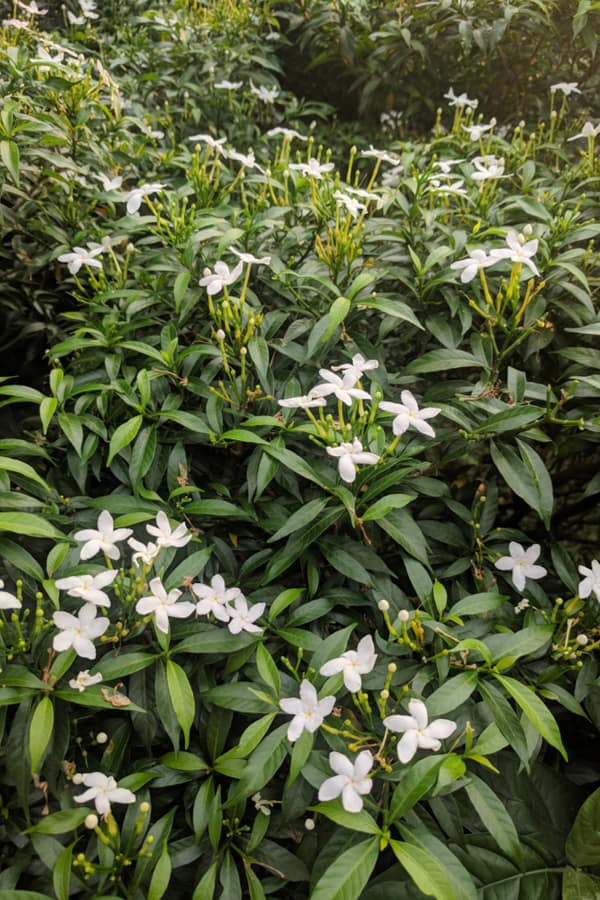
Summer Jasmine (Common Jasmine, Poet’s Jasmine, true Jasmine, white Jasmine) is a deciduous climber. This flower is well known for its beautiful white, five-petaled flowers and slightly-fuzzy foliage.
It will bloom throughout the summer if you grow it in your garden. When planted indoors, this flower will flourish most of the year. This semi-evergreen variety is the Pakistan state flower.
2. Jasminum polyanthum

Pink Jasmine (Chinese Jasmine, winter-blooming Jasmine) is probably the most popular variety you can find on the market. This twining climber can grow up to 6 feet (1.8 m) if you provide proper support to help it thrive and grow well.
If you decide to grow Jasmine indoors, you won’t have to spend much time on its care. Just prune your plant frequently, and it will blossom during the whole winter. I adore its numerous pink buds appearing in spring and developing into five-petaled white blooms, which look like stars.
Jasmine Varieties |
|
|
Variety |
Flowers |
|
Jasminum officinale – summer type |
White, five-petaled flowers |
| Jasminum nudiflorum – winter type |
Brilliant yellow flowers |
|
Jasminum fruticans |
Yellow, entirely odorless flowers |
| Jasminum polyanthum |
Pink buds develop into five-petaled white, starry flowers |
|
Tabernaemontana divaricata |
Curled white, pinwheel flowers |
| Jasminum sambac |
Highly fragrant white flowers forming clusters |
|
Jasminum parkeri |
Yellow, lightly fragrant, five-petaled flowers forming clumps |
| Jasminum grandiflorum |
Lovely white flowers |
|
Jasminum dichotomum |
Pink buds, which flourish into white, six-petaled flowers |
| Murraya paniculata |
Fragrant orange flowers forming tiny clusters |
|
Jasminum mesnyi |
Yellow, highly fragrant trumpet-shaped flowers |
| Jasminum fruticans |
Tubular yellow flowers |
3. Jasminum sambac
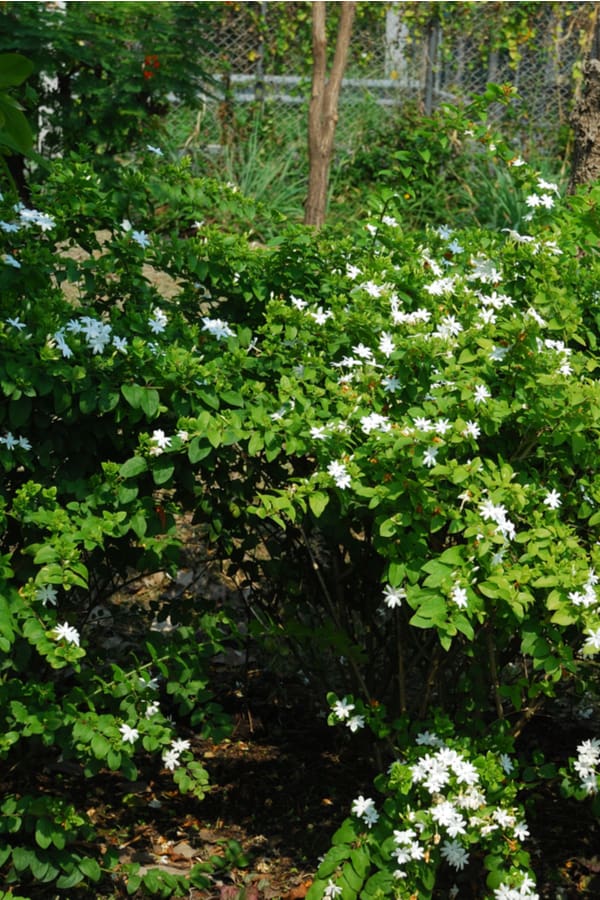
Arabian Jasmine is a unique, evergreen vining flower which originated in the Himalayas. Nowadays, this type of Jasmine is a national flower of Philippine and Indonesia.
This flower with white fragrant blooms, which form clusters of 3 to 12 flowers, can grow from 4 to 10 feet (1.2 – 3 m) tall. If you plant it in your garden, you will get magnificent blooming throughout the year.
4. Jasminum mesnyi
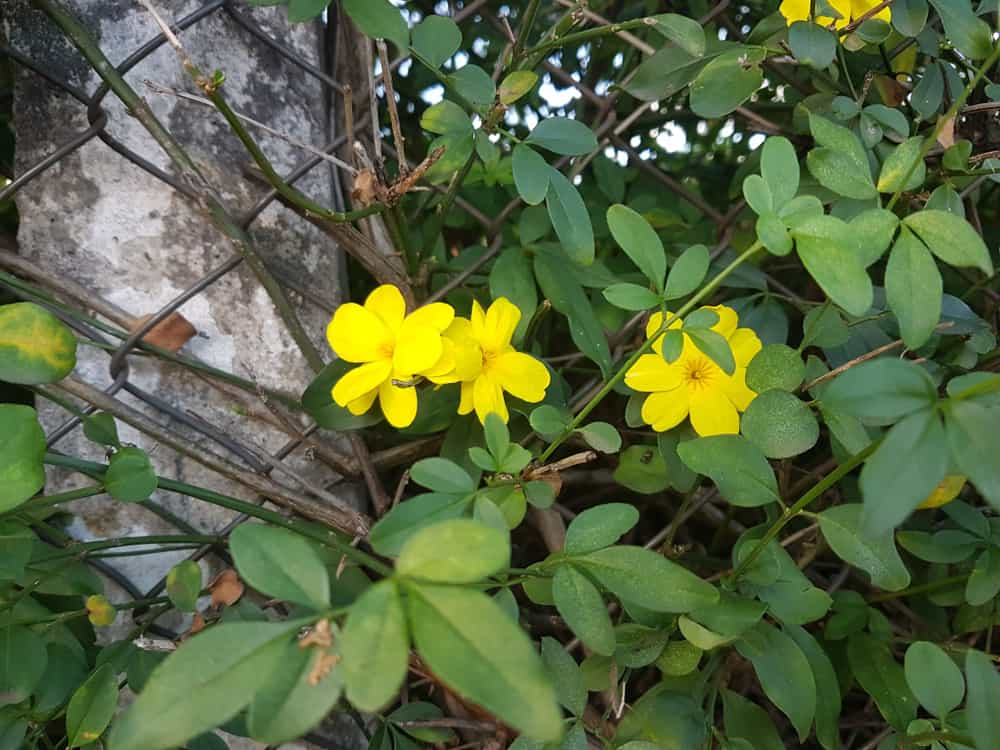
Japanese Jasmine (Primrose Jasmine) can reach a height of about 10 feet (3 m) while producing numerous yellow, highly fragrant trumpet-shaped flowers.
Since the stems of this plant are long and strong, they will climb effortlessly, and you don’t need to provide support for them.
Try to prune your flower lightly after flowering, but take care not to over-prune. You want your lovely plant to stay gracious and beautiful.
5. Murraya paniculata

Orange Jasmine (Lakeview Jasmine, orange jessamine) is well-known for its astonishing orange blossoms and oval, deep-green shine foliage. Plant this flower in your yard, and you will enjoy this 8 to 12 feet (2.4 – 3.6 m) tall plant with leaves, which can reach up to 2.75 inches (7 cm) long.
Sweetly fragrant flowers form tiny clusters, which always appear in spring and attract butterflies, bees, and birds. Since they can’t stand direct sunlight, plant your Jasmine in a place with enough morning sun and partial afternoon shade.
This variety doesn’t make vines, but you can use it for creating attractive hedges or forming a small tree in the special place in your yard.
6. Tabernaemontana divaricata

Crepe Jasmine (Pinwheel Jasmine) is actually a highly fragrant shrub, which can grow up to 10 feet (3 m) high. Provide full sun or partial shade for this plant, and enjoy its curled white, pinwheel flowers.
7. Jasminum grandiflorum
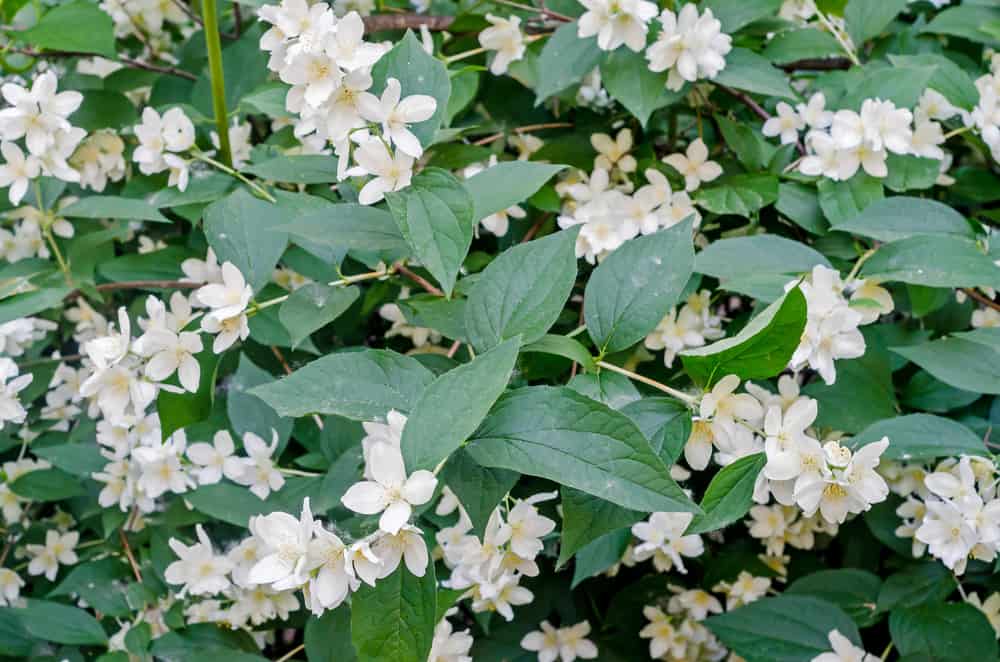
Spanish Jasmine (Royal Jasmine) is usually raised for the scent of its lovely white flowers, which are highly appreciated in the perfuming industry.
8. Jasminum nudiflorum

Winter Jasmine blooms in late winter and early spring. Its brilliant yellow flowers grow on vines, but many gardeners use this variety as a ground cover.
9. Jasminum parkeri

Dwarf Jasmine is an ideal choice for growing in a container. Nowadays, this evergreen shrub is popular as a part of much topiary. You will adore its yellow, lightly fragrant, five-petaled blooms forming clumps.
10. Jasminum dichotomum

Gold Coast Jasmine is a woody vine that originated in Africa. If you plant this variety, you can enjoy its pink buds, which flourish into white, six-petaled blooms.
It will flourish throughout the year when you grow it in warm climates. Since it spreads rapidly, it is considered an invasive flower in many States.
11. Jasminum fruticans

Wild Jasmine, which originated in the Mediterranean, usually reaches up to 4 feet (1.2 m) tall. Its seductive yellow flowers bloom from spring to fall.
Surprisingly, they are entirely odorless. This variety is probably the oldest one, and it was mentioned for the first time in Venice, Italy in 1545.
How to Plant Jasmine Flowers in Your Garden
Choose the right plant

Since there are more of 200 species of this beautiful flower, the first step is to choose the right one, which will suit your garden best.
Pick out an evergreen or deciduous plant, vines or shrub form, or choose a variety suitable for indoor growth. That depends only on your preferences and the weather conditions in the region you live in.
If you don’t want to purchase young plants in pots available at a local store or nursery, you can order seeds on the Net.
Find the right place

After buying seeds, you should determine a spot which will suits best to your new plant. Your choice will depend on the specific environmental needs of every type of flower.
The ideal place should have the right level of light, which means that you need to plant Jasmine on direct sunshine with partial afternoon shade. In fact, provide the warmest part of the garden for flower permanently planted outside.
Then determine if your Jasmine is a hardy type or you should remove it inside during winter months. In the end, measure the space depending on your decision to plant vines cultivars, ground cover, bushes, or dwarf types.
Prepare the soil and start planting

You don’t need to worry if the soil in your garden is fertile and well-drained. Otherwise, add a layer of at least 2 inches (5 cm) of compost to enrich the ground. That way, you will ensure the healthy flourishing of your Jasmine throughout the whole growing season.
Use the gardening hoe to dig a hole, fill it with water, and measure the time it takes for water to drain from there. If it soaks quickly, the ground is well-drained, and the place is perfect for your Jasmine. Otherwise, look for the other one.
Take your Jasmine away from the container and water the root ball. Put the young plant into the dug hole, which is at least twice the size of the ball of the roots.
After putting the plant inside the hole, add the soil, and take care to be a bit taller than the level of the ground. That way, you will make further watering more efficient. Lightly pat the ground around the plant with your hand and water it with garden watering can.
Sowing seeds

Even though it requires more time and effort, there is also a possibility to start this lovely flower from seeds. The process is not so complicated, but be prepared that jasmine seeds have a quite low rate of germination. Plus, they require additional care.
Sow seeds indoors in a pot filled with quality starter mix. After the period of hardening your seedlings, you can transplant them in the garden after the last frost pass.
Planting semi-ripe cuttings

If you have a mature Jasmine in your yard, you can take a semi-ripe cutting from it in mid-summer. Pick out a healthy, 6 inches (15 cm) long stem, and place it in the pot.
Add well-drained soil and mature compost in it. Keep the pot in a sunny windowsill during winter and transplant young plant in your garden in the early spring.
How to Care Jasmine in Your Garden
Soil
Prepare porous and well-drained soil for your Jasmine, and modify it when necessary by adding bark or coir. Since this plant is heavy feeder, it is better avoiding clay and other poor soils. Keep in mind that some varieties prefer the sandy ground.
Light

You need to provide at least 6 hours of direct sun for your Jasmine. However, it may vary depending on the species of this beautiful flower.
In general, most of them require full sun, especially summer Jasmine. On the other hand, winter Jasmine will tolerate full sun to partial afternoon shade. Be careful because even this particular variety can’t thrive in dense shade.
If you grow your plant indoors, you should provide enough daylight for it and excellent air circulation. Only that way you will enjoy blossoms in winter.
Temperatures
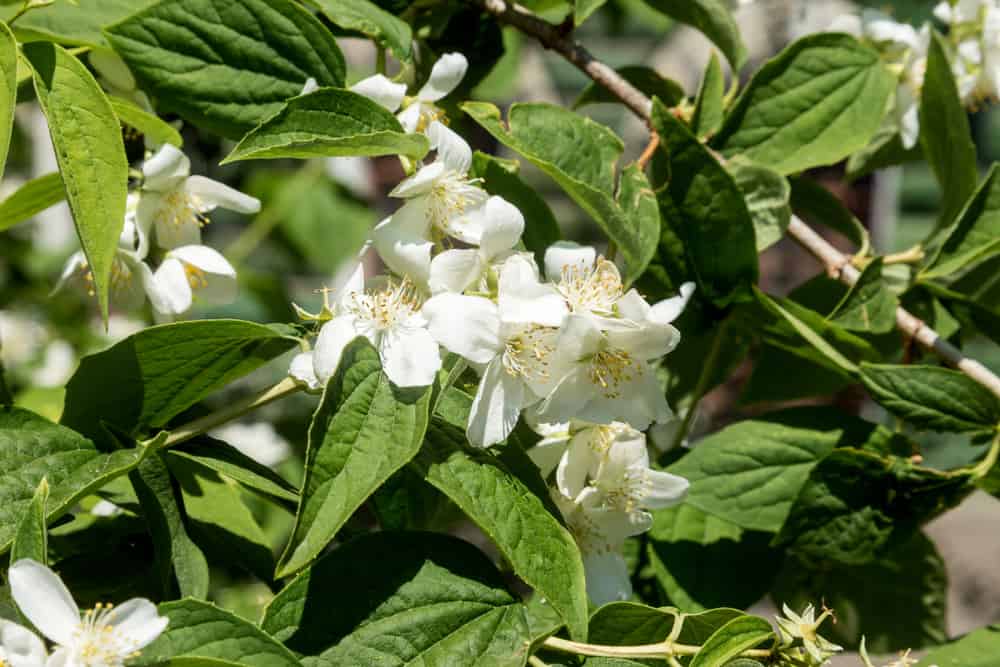
As every tropical plant, Jasmine prefers higher temperatures and humid environment. If you want your flower to survive, provide the temperatures from 60 to 75 F (15.5 – 24 C) even during winter.
After blooming is finished, your plant will tolerate staying in a colder place, but minimal temperature it can survive is 41 F (5 C).
Watering

One of the most important things is watering your Jasmine regularly. This flower won’t tolerate too soggy soil, but you should ensure enough moisture for its healthy growth. If you don’t do the job well and over-water your plant, the result will be root rot and its death.
On the other side, Jasmine needs more water while blooming. It is ideal watering it at least once a week during that period.
Plants grown indoors may tolerate more humidity because the evaporation helps Jasmine blooms abundantly. However, these flowers don’t want to become soaked either.
Fertilizing
It is necessary to feed your Jasmine regularly if you want it grows healthy and vigorous. In general, you can use a standard balanced fertilizer, but there are a lot of others you can use to get specific results you want.
Add fertilizer high in nitrogen, which will encourage the growth of your flower. When you want to get more abundant blooming, you should increase the level of phosphorus and potassium as well.
Pruning
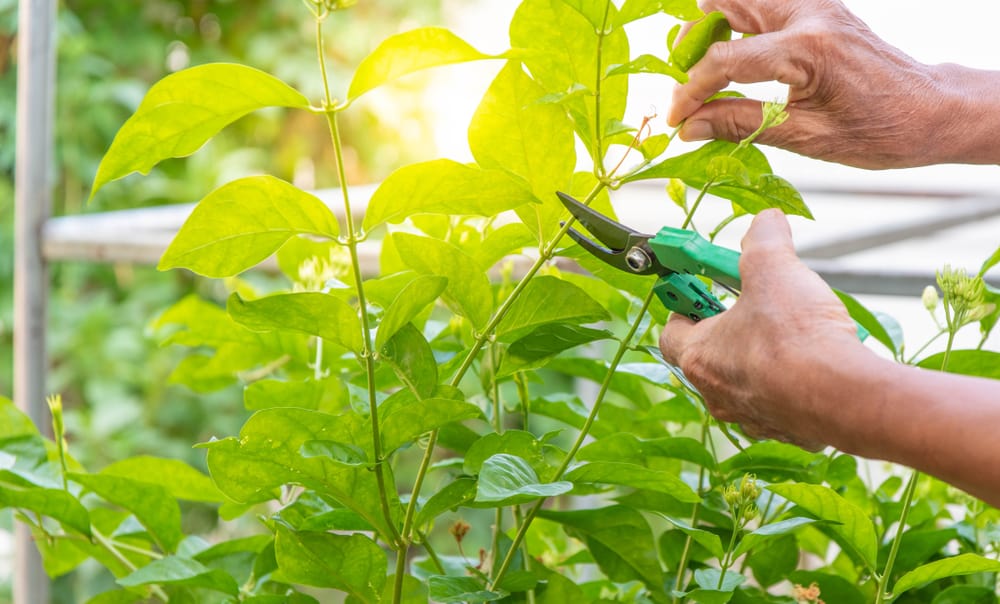
Pruning needs may vary depending on the variety of Jasmine you decide to grow.
For example, you should prune summer Jasmine immediately after blooming in late summer. On the other hand, the best time for pruning winter Jasmine is spring, right away after the period of flowering.
In both cases, you will give enough time to your plant to mature and prepare itself for flowering in the next season.
The process of pruning is quite simple. Cut wilted flowers and remove weak and dried stems.
Since Jasmine tolerates hard pruning, you can cut your plant to within 2 feet (61 cm) of the base if necessary. Keep in mind that, in such a case, your flower won’t flourish at least two or three following years.
Jasmine Flowers Pests and Diseases

- Budworm – You may find clusters of larvae in the buds, causing their falling. Use the neem oil to keep a problem under control.
- Blossom midge – These destructive worms attack the buds until they dry and die. The only solution is to collect and destroy the affected buds.
- Eriophyid mite – Since mites are tiny, you can’t see them. However, you will notice damage to the flower. Spray neem oil to control the additional spread of these creatures.
- Leaf blight – In the very beginning, you will spot the reddish-brown patches on the upper part of the foliage. The result will be curling and drying out the leaves, as well as the reduction in the production of flowers. Mix baking soda in water and spray it on the plant.
- Rust – Fungi will cause the occurrence of orange-colored pores and consequential death of your plant. Solve the problem by spraying the flowers with the baking soda solution.

Leave a comment